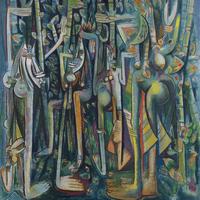More about Wifredo Lam
Works by Wifredo Lam

Contributor
Wifredo Lam's roots run deep.
The Cuban artist was of Congolese-African and Spanish descent, thanks to his mother, and Cantonese Chinese descent thanks to his father. His aunt was a Santeria priestess, a colorful religion that is rooted in West African rituals and blended with Catholic elements. So, there were plenty of cultural and artistic influences around Lam. One of the biggest was his father, Yam Lam, who immigrated from San Francisco to Havana, where he worked as a calligrapher in their community in Cuba. It was through his father that Lam learned the art of traditional ink painting and calligraphy, as well as the traditions of Chinese ancestral worship.
Lam was influenced by themes of mysticism and the occult from his own multi-cultural background, as well as those he encountered while traveling around the world. He learned about Shang oracle bones, ancient Chinese tools for divination, witnessed outlawed Haitian Vodou ceremonies, secret Ñáñigo (Afro-Cuban) rituals, and even saw a fortune teller in Havana. Although his aunt saw his potential to become a seer (she thought her nephew was a sensitive kid), Lam chose art as his path and traveled to Spain to study at Madrid’s Royal Academy of San Fernando, learning from Fernando Alvarez de Sotomayor, and frequenting the Prado Museum where he studied the masterpieces of El Greco, Diego Velázquez, Hieronymus Bosch, and Albrecht Dürer.
Lam spent around eighteen years in Spain and France, making friends with bonafide superstars like Pablo Picasso, Henri Matisse, and surrealist Andre Breton. Picasso and Breton weren’t only friends of Lam, but huge supporters of his work. Picasso, in particular, helped Lam to make connections and get exhibitions. Picasso introduced Lam to African art in the shape of a mask that was sitting on Picasso’s table. Of this mask, Picasso would tell Lam, “You should be proud of your ancestors.” However, Europe wasn’t all about hanging out with intellectuals, drinking café, and talking art. Lam had a brush with tragedy in Spain when his wife Eva and infant son were struck down by tuberculosis in 1931. The traumatic event got Lam thinking about wealth distribution, as he felt that if he were wealthy, his family could have had a better chance at survival. As one gallery puts it: "It was around this time that Lam experienced a political awakening, a revelation that made him want to convey what he described as “a general democratic proposition […] for all people…” with his art."
Following this trend, Lam fought for the Republicans in the Spanish Civil War, but when General Franco succeeded in Barcelona, Lam hiked it for Paris. Finally, the outbreak of World War II sent Lam back to Cuba in 1941. On his departure, Lam bumped into Breton and a group of intellectuals hoping to flee Nazi-occupied Europe. They traveled to Martinique, where they were imprisoned by the pro-Nazi Vichy government. When Lam was eventually released and returned to Cuba, his art began to grapple with the Afro-Cuban history of slavery and colonialism, inspired in part by these experiences in Europe, during the Spanish Civil War, and his forced passage in Martinique. Back in Cuba, Lam immersed himself in his native island's culture, as well as those of other countries of the African diaspora. Of this Lam says, "I could have been a good painter from the School of Paris, but I felt like a snail out of its shell. What really broadened my painting was the presence of African poetry.”
Sources
- Hudson, Mark, “Wifredo Lam: the unlikely comeback of the Cuban Picasso,” Telegraph, August 31, 2016. Accessed October 19, 2020. https://www.telegraph.co.uk/art/what-to-see/wifredo-lam-the-unlikely-co…
- Jones, Jonathan, “Wifredo Lam review – Cuban’s last of the true surrealists,” The Guardian, September 13, 2016. Accessed October 19, 2020. https://www.theguardian.com/artanddesign/2016/sep/13/wifredo-lam-review…
- McEwen, Abigail, “Exploring Wifredo Lam and his Afro-Chinese-Cuban heritage,” Phillips, accessed October 19, 2020. https://www.phillips.com/article/37862582/exploring-wifredo-lam-and-his…
- Mutual Art, “Wifredo Lam’s Western celebration of African heritage,” August 4, 2020. Accessed October 19, 2020. https://www.mutualart.com/Article/Wifredo-Lams-Western-Celebration-of-A…
- Nathan, Emily, “Rediscovering the sensual multiculturalism of Wifredo Lam at Centre Pompidou,” Artnet News, October 2, 2015. Accessed October 19, 2020. https://news.artnet.com/exhibitions/wifredo-lamparis-pompidou-337035
- Nechvatal, Joseph, “Wifredo Lam by way of an Afrofuturist graffiti artist,” Hyperallergic, January 21, 2016. Accessed October 19, 2020. https://hyperallergic.com/269887/wifredo-lam-by-way-of-an-afrofuturist-…
- Prensa Latina, “Cuba recalls Wifredo Lam on his death anniversary,” date accessed October 19, 2020. https://www.plenglish.com/index.php?o=rn&id=59715&SEO=cuba-recalls-wifr…
- Sothebys, “Wifredo Lam masterpiece to be offered for sale by Sotheby’s,” Salon Prive Magazine, June 20, 2020. Accessed October 19, 2020. https://www.salonprivemag.com/wifredo-lam-masterpiece-to-be-offered-for…
- Wullschlager, Jackie, “Wifredo Lam: between the world and me,” Financial Times, September 16, 2016. Accessed October 19, 2020. https://www.ft.com/content/81786ca0-799c-11e6-97ae-647294649b28
- Diane de Polignac Gallery, "Wilfredo Lam," translated by Lucy Johnston. https://dianedepolignac.com/en/home-gb/artists-en/00-wifredo-lam-gb/#bi…
Featured Content
Here is what Wikipedia says about Wifredo Lam

Wifredo Óscar de la Concepción Lam y Castilla (Chinese: 林飛龍; Jyutping: lam4 fei1lung4; December 8, 1902 – September 11, 1982), better known as Wifredo Lam, was a Cuban artist who sought to portray and revive the enduring Afro-Cuban spirit and culture. Inspired by and in contact with some of the most renowned artists of the 20th century, including Pablo Picasso, Henri Matisse, Frida Kahlo and Diego Rivera, Lam melded his influences and created a unique style, which was ultimately characterized by the prominence of hybrid figures. This distinctive visual style of his also influences many artists. Though he was predominantly a painter, he also worked with sculpture, ceramics and printmaking in his later life.
Check out the full Wikipedia article about Wifredo Lam












